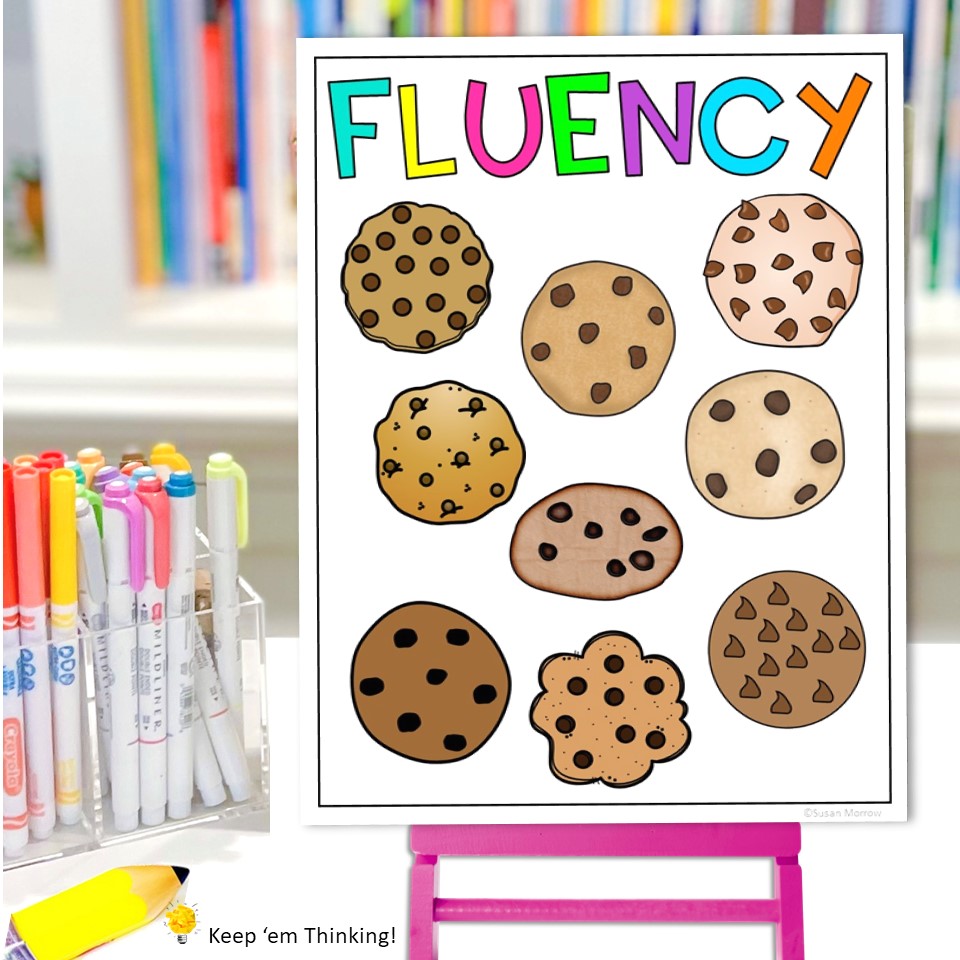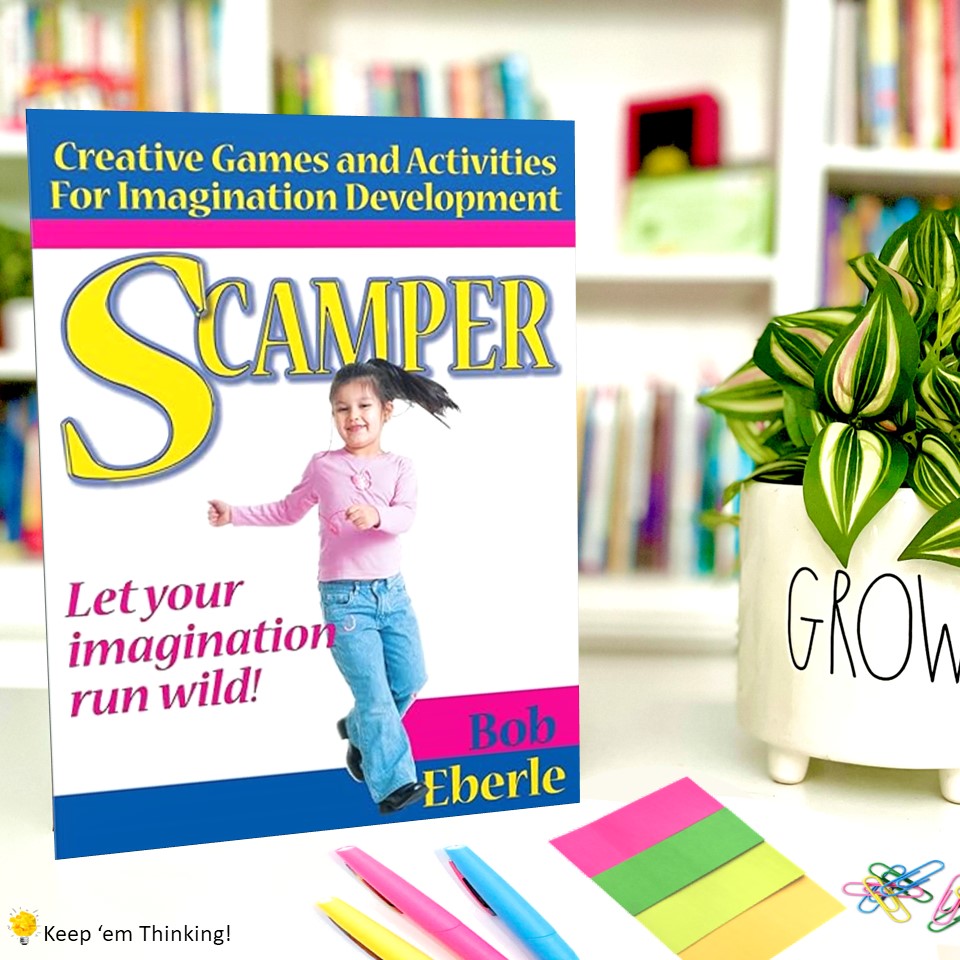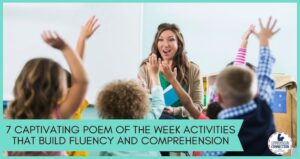Brainstorming is one of my favorite cooperative learning strategies to spark creativity and critical thinking in my students. It boosts problem-solving skills and nurtures a sense of community in the classroom. But more importantly, brainstorming encourages creativity, enhances communication, and builds a foundation for collaborative and independent thinking.

I’m sure you’ve witnessed the magic that happens when kids have opportunities to work together. Their eyes light up, ideas bounce around, and learning becomes a joyous adventure. That’s the heart of cooperative learning – it’s all about teamwork, sharing, and growing together. Brainstorming is my favorite collaborative learning strategy. It’s like a classroom think tank, where every student can contribute their ideas. It’s a time when out-of-the-box thinking is encouraged.

When we began studying ecosystems in my classroom, I kicked things off with an interactive approach rather than just relying on the textbook. I began by posing a thought-provoking question to my students: “What would happen if bees disappeared?” Asking questions such as these opens up a lively brainstorming session, where the room buzzes with a variety of ideas. Students eagerly share their thoughts, ranging from the wildly imaginative to deeply insightful.
Posing “what if” questions is a fantastic way to encourage fluency, flexibility, originality, and elaboration of thought – the key elements of effective brainstorming. By incorporating brainstorming into your lessons, you’re not just teaching facts; you’re cultivating a space where students can think independently, view issues from different angles, conceive innovative ideas, and then develop those ideas further.

But brainstorming is not just about the ideas. It’s also about learning to listen, respect different viewpoints, and build on each other’s thoughts. That’s where cooperative learning shines through. We’re fostering a classroom culture where every student feels valued and heard and where learning is a team effort.

What are the Benefits of Brainstorming?

There are too many benefits of using brainstorming strategies with your kiddos to mention in this post, but here are my top four:
- Encourages Critical Thinking: It pushes students to think beyond the obvious, question, and explore new possibilities.
- Boosts Confidence: When kids see that their ideas are valued, it boosts their self-esteem. They’re more likely to participate and take risks in learning.
- Enhances Communication Skills: As students share and discuss their ideas, they learn the art of communication – expressing themselves clearly and listening to others.
- Fosters Creativity: Brainstorming is all about thinking outside the box. It nurtures creativity, which is not just great for art class but for problem-solving in every subject.

Key Components of Effective Brainstorming
There are a number of key components that make brainstorming sessions not just fun, but effective. Understanding these elements can help us tailor our sessions to be more engaging and productive for our young learners.
Fluency: The Power of Idea Generation
First up, fluency. This is all about the quantity of ideas generated. In our classrooms, this means encouraging students to come up with as many ideas as possible, no matter how outlandish they might seem. In this stage of brainstorming, judgment is deferred. The goal here is to get those creative gears turning and to emphasize that in brainstorming, more is merrier.
The poster below illustrates the concept of fluency around the idea of chocolate chip cookies. There are many chocolate chip cookies here. Fluency is all about getting as many ideas out there as possible.
- Tip for Teachers: I like to set a timer and challenge the class to come up with as many ideas as possible within a set time. Make it a fun competition to see which group or individual can come up with the most.
Flexibility: Diverse Thinking for Diverse Learners
Flexibility in brainstorming refers to the ability to produce a variety of ideas. It’s about thinking differently and approaching a problem from multiple angles. This is particularly important in a diverse classroom where each child brings a unique perspective.
In the flexibility poster, you see many cookies, but they are all different kinds of cookies. Some, like the fortune cookie might be considered unusual.

- Classroom Activity: A fun activity is to show the class a common object and ask my students to think of many, different uses they can think of for this object. This activity teaches students that there’s more than one way to look at things.
Originality: Encouraging Unique Ideas
Originality is the heart of creative thinking. It’s about coming up with new, unique ideas that haven’t been expressed before.
In the originality poster, we see the chocolate cookie being used in a unique way as wheels on the wagon. Original ideas are those that no one else has thought of. In the classroom, this looks like an idea that no one else in the group or class has presented.
- Encouraging Originality: Applaud and celebrate unique ideas, even if they seem offbeat. This reinforces the value of thinking differently and being original. Ask your children to come up with an idea that no one else in their class or group has thought out.
Elaboration: Adding Detail to Ideas
Last but not least, elaboration. This component is about adding details to an idea, fleshing it out, and thinking about its implementation. It’s where ideas start taking shape and become more than just abstract thoughts. This is my favorite component of brainstorming.
In the elaboration poster, we see a plain cookie outline transformed into a picture of a decorated cookie holding a magnifying glass and a jar of lightning bugs. You see a lot of elaboration or details have been added to the original picture.
- Classroom Strategy: Once students develop an idea, I ask them to expand on it. How would that work? What would you need to make that happen? Can you draw it? What can you add to your idea? Questions like these encourage deeper thinking and problem-solving skills.
Bringing it All Together
In my classroom, the goal of brainstorming goes beyond just uncovering the correct answer. It’s about nurturing a mindset that is inherently curious, imaginative, and fearless in exploration. This focus on key elements of brainstorming helps me guide my students towards becoming more than just learners. They evolve into thinkers and innovators. By emphasizing curiosity and creativity, I hope create a classroom environment where innovative thinking is the norm and equip them with the skills and confidence needed to face problems.

Integrating Brainstorming Into Collaborative Learning Environments

Combining brainstorming with cooperative learning creates a highly effective learning experience. Here’s how I try to make this happen in my classroom.
Creating the Right Environment
In order to ensure the success of our brainstorming sessions, I focus on creating a classroom environment where my students feel both comfortable and eager to engage. This involves setting up the classroom in a way that promotes interaction and collaboration among them. I often arrange the desks in circles or small groups, fostering a sense of community and teamwork. It’s also important to ensure there is ample space for the students to move around, allowing them to interact more freely with one another. This layout not only facilitates better communication and idea exchange but also helps in building a more dynamic and inclusive learning atmosphere.
- Pro Tip: I like to use colorful posters or visuals around the room to stimulate creativity and set a vibrant tone for brainstorming sessions.
Structuring the Brainstorming Process
When it comes to structuring the brainstorming process, clarity is key. I like to lay out clear guidelines, so students know exactly what to do. This might include setting a specific topic or question to brainstorm, explaining the rules (like no idea is a bad idea), and setting a time limit to maintain a lively pace and keep the ideas flowing.
- Classroom Activity: Start with a warm-up exercise like a quick word association game to get those creative juices flowing before diving into the main brainstorming session. Example: Think of many different and unusual words you can associate with the word dinosaur.
Facilitating Group Discussions
As a teacher, I recognize the pivotal role I play in facilitating group discussions during team brainstorming sessions. My responsibility includes guiding the conversation, ensuring that each student gets an opportunity to voice their thoughts, and assisting them in expanding upon each other’s ideas. Being an active listener is equally important, as it allows me to provide constructive and positive feedback, which in turn encourages and motivates my students.
To reinforce this process, I find it helpful to have a visual display of the rules of brainstorming prominently posted in the classroom. This visual serves as a constant reminder to the students of the guidelines and principles we follow during our brainstorming sessions. It not only helps in maintaining a structured approach but also fosters a consistent and inclusive environment for idea sharing.
- Remember: Be sure to remind the students that there are no bad ideas and that during brainstorming sessions, all judgment is deferred. The goal is to create a safe space where students feel comfortable sharing their thoughts without fear of judgment.
Encouraging Diverse Perspectives – All ideas are accepted – Defer Judgment
One of the most rewarding aspects of cooperative learning in my classroom is its ability to unite students from diverse backgrounds and perspectives. I actively encourage my students to share their unique viewpoints and experiences during brainstorming sessions. This not only enriches the discussion but also provides a valuable opportunity for the students to learn about and respect diversity. Such exchanges broaden their understanding and appreciation of different perspectives, fostering a more inclusive learning environment.
After each brainstorming session, I plan time for the class to reflect together. We discuss what parts of the session worked well and areas for improvement. This reflection time helps students to internalize their learning experiences and understand the significance of their contributions.
Bringing it to Life
Finally, I strive to find ways to actualize some of the ideas that emerge from our brainstorming sessions. Whether it’s through a small project, a class presentation, or even modifying the classroom setup, it’s important to demonstrate to the students that their ideas are valuable and can be brought to life. This approach is incredibly empowering for them, as it shows that their thoughts and suggestions can have a tangible impact.
By integrating brainstorming into our class activities, we are accomplishing more than just covering the curriculum. We are nurturing critical thinkers, honing effective communicators, and fostering creative problem-solvers. This method goes beyond traditional teaching; it prepares students with essential skills for their future, ensuring they are equipped not just with knowledge, but with the ability to apply it in innovative and meaningful ways.

Methods of Brainstorming for the Elementary Classroom
In the following blog post, I share activities to inspire creative thinking include a few brainstorming strategies.
Scamper
I’m sure you’ve heard the expression that there are no new ideas – just modifications of existing ones. Welcome to SCAMPER, a technique originally developed by Alex Osborn and then modified and adapted by Bob Eberle. It is a form of brainstorming where students use a list of questions to help them think of new ideas.
In my classroom, when introducing the SCAMPER brainstorming exercise, I begin by presenting the challenge or problem that needs to be addressed. Once the challenge is clear, I guide the class through each of the seven SCAMPER thinking stems or verbs, focusing on one at a time. I allocate at least 5 minutes for the students to explore each stem, allowing them ample time to think and generate ideas.
The primary goal here is to encourage the students to come up with as many ideas as they can. In line with the brainstorming rules, every idea is welcomed and valued, regardless of how unconventional or outlandish it might seem, and judgement is temporarily set aside. This approach fosters a safe and open environment for creative thinking.
I recommend the book SCAMPER by Bob Eberle to learn more about the SCAMPER technique. Just click on the image below to learn more about the book.
When I’m first introducing SCAMPER, I find it effective to have the kids apply this type of brainstorming to an everyday object, such as a bicycle or a backpack. This familiar context makes it easier for them to grasp the concept and apply the SCAMPER method creatively. This activity not only enhances their ability to think outside the box but also helps them see ordinary objects in a new and innovative light.
Squiggle Lines
Squiggle Lines is an engaging and creative brainstorming technique I like to incorporate into my classroom, especially when we have a few spare minutes. It’s not only fun but also serves as an excellent measure of creativity and original thinking among the students.
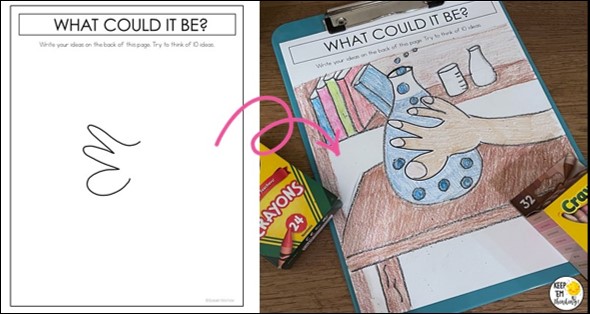
The materials required are quite simple: copies of pages with squiggle lines, pencils, erasers, and crayons. The task for the students is to observe the squiggle line and imagine it as a part of many different and unusual things. I usually set a goal for each student to come up with 10 ideas. The rationale behind this number is that the first few ideas are often the most common responses, and pushing beyond that encourages deeper creativity.
It’s not uncommon for students to initially come up with three ideas and then hit a roadblock. At this point, I encourage them to rotate their page and view the squiggle from different angles. This simple change in perspective can spark new ideas. I remind them that the goal is to think of ideas that they believe no one else would come up with, emphasizing originality and uniqueness.
Once they have their ideas, I ask the students to use pencils to add details and complete their pictures. Only after they have thoroughly drawn and detailed their pictures do they move on to coloring them. This process ensures that they focus on the creative aspect of their drawings first. With younger students, I sometimes delay giving them crayons until they’ve completed their drawings, to ensure that they fully engage with the creative process before focusing on coloring.
Things I look for in the drawings:
- Look to see which students turned their pictures into things no one else in the class thought of.
- Look for drawings that display lots of elaboration or details.
- Look for drawings that display humor.
- Look for drawings that show the picture or object from an unusual angle, such as a bird’s eye view.
- Look for drawings in which the picture extends off the page.
Creative Problem Solving
Creative Problem Solving is a vital skill for children, equipping them with a structured approach to tackling complex challenges. In a rapidly changing and interconnected world, the ability to think creatively and solve problems is essential. CPS develops critical thinking, enhances creativity, encourages a growth mindset, and prepares students for future uncertainties and challenges.
The Creative Problem Solving (CPS) process, as outlined by Sidney Parnes, is an invaluable framework for educators to nurture and guide the creative potential in their students. This process consists of six distinct stages:
The Big Mess: This initial stage is about identifying and acknowledging the complexity of a situation or challenge. It involves recognizing the intricate web of factors, emotions, and perspectives contributing to the ‘mess.’ For teachers, this means guiding students to see beyond the surface of a problem and appreciate its complexity.
Fact Finding: Here, the focus shifts to gathering information. It involves researching, observing, and collecting data relevant to the problem. Educators play a crucial role in teaching students how to effectively source and analyze information, discerning what is relevant and what is not.
Problem Finding: This critical stage involves defining and refining the problem. It’s about understanding the core issue at hand. Teachers can help students develop the skill to articulate a problem clearly and concisely, which is essential for the subsequent stages.
Idea Finding: This stage is the heart of the creative process. It’s where brainstorming and ideation happen. Students are encouraged to think divergently, proposing as many solutions as possible without judgment. Educators foster an environment where creativity is unleashed, and every idea is valued.
Solution Finding: In this stage, the focus is on convergent thinking. It’s about evaluating the generated ideas, considering their feasibility, and selecting the most viable solutions. I try to guide students in critical thinking and decision-making, and help them to weigh pros and cons effectively.
Acceptance Finding: The final stage involves planning and persuasion. Students learn to communicate their solutions effectively and consider how they can be accepted and implemented. This involves understanding the audience and stakeholders and developing strategies to overcome obstacles and resistance.
Creative Problem Solving is crucial for children as it equips them with a structured approach to tackling complex challenges. In a world that is rapidly changing and increasingly interconnected. The ability to think creatively and solve problems is not just beneficial but essential. CPS helps develop critical thinking, enhances creativity, encourages a growth mindset, and prepares students to face the uncertainties and challenges of the future.
By integrating CPS into the curriculum, I try to provide students with the tools they need to navigate their personal and professional lives successfully, fostering a generation of innovative thinkers and problem solvers. My favorite book for teachers about Creative Problem Solving is CPS For Kids by Bob Eberle and Bob Stanish. Click on the images below to learn more about this great resource.
Ways to Use Creative Problem-Solving
- In Counseling Sessions – CPS can be used to help our students navigate personal challenges. Students can learn to identify their real issues, generate potential solutions, and develop plans to overcome obstacles.
- In Book Studies – When students engage with literature, they can use CPS to dig deeper into the narrative as they think of creative ways to solve problems or obstacles described in the story.
- Social Studies Lessons – CPS can transform history and geography lessons into exciting explorations of past and present problems. Students can examine historical events and apply CPS to propose alternative outcomes.
- Morning Meetings – Class Meetings – Students can discuss and address class-related challenges such as organizing an event or resolving conflicts.
By incorporating CPS across different aspects of learning and classroom activities, I aim to provide my students with versatile tools that not only aid in academic success but also equip them with skills necessary for personal growth and social interaction.
Mind Mapping for Young Minds

Mind mapping is a fantastic tool for visual learners. It allows students to visually organize information, making complex ideas simpler to understand and remember.
- How to Implement: Start with a central idea and have students brainstorm different elements related to it, connecting these elements with lines or arrows. This can be done individually or in groups, on paper or using digital tools.
One of the best sources I have found for tips on using mind maps or concept maps is Reading Rockets. You can check out their blog post here.
Brainwriting in Group Settings
Brainwriting is a method I use in my classroom as an alternative to traditional verbal brainstorming. It’s particularly effective in ensuring that every student has the opportunity to contribute, especially in a diverse classroom where some students might be more outspoken than others.
In this activity, I organize the students into small groups, typically consisting of 5-6 members. Each student starts with a piece of paper where they write down their own ideas on the given topic or challenge. After a set amount of time, which can be a few minutes, each student passes their paper to the next person in the group. The next student then reads the existing ideas and adds their own thoughts to the paper. This process continues until everyone in the group has had the chance to contribute to each paper.
One of the key benefits of brainwriting is that it allows quieter students to express their ideas without the pressure of speaking up in a group setting. It also prevents more vocal students from dominating the discussion, ensuring a more balanced and inclusive contribution from all members of the class. Additionally, this method can often lead to a more diverse range of ideas, as students have the time to think and build upon others’ thoughts without the immediacy and sometimes competitive nature of verbal brainstorming.
- Classroom Tip: Use brainwriting when you want to ensure quieter students have equal opportunity to contribute their ideas without the pressure of speaking in front of the whole class.
Round Robin Brainstorming
Round Robin Brainstorming is a structured and inclusive technique I utilize in my classroom to encourage idea generation and participation from every student. In this approach, students are arranged to sit in a circle, fostering an environment of equality and visibility among all participants.
The process is straightforward yet effective: each student, in turn, contributes one idea related to the topic at hand. We go around the circle, giving each student the opportunity to voice their thoughts without interruption. This method ensures that every student has a chance to participate, making it particularly valuable in a diverse classroom setting where some students might be more reserved or hesitant to speak up.
The Round Robin format is beneficial as it creates a systematic and respectful environment for sharing ideas. It helps in minimizing the dominance of more outspoken students and gives quieter individuals a designated space and time to express their thoughts. This approach not only aids in generating a wide range of ideas but also fosters a sense of community and respect among students, as everyone’s input is given equal attention and importance.
- Effective Use: Round Robin is great for generating a large number of ideas in a short amount of time. It also helps in building listening skills as students need to pay attention to others’ ideas to avoid repetition.
What If? Scenarios
In my classroom, I often employ the strategy of posing hypothetical What If? scenarios to encourage creative thinking among my students. This method is particularly effective in pushing them to think beyond conventional boundaries and explore alternative realities or situations.
By presenting these What If? questions, I invite students to imagine different circumstances and outcomes. For instance, I might ask, “What if gravity didn’t exist?” or “What if you could travel back in time?” These kinds of questions stimulate their imagination and prompt them to consider possibilities outside of their normal realm of thought.
This approach not only sparks creativity but also enhances critical thinking skills, as students must analyze and reason through these hypothetical scenarios. It encourages them to be innovative in their thought process and to envision a range of possibilities and consequences. Such exercises also make learning more engaging and enjoyable, as they allow students to think freely and creatively without the constraints of conventional classroom answers.
- Application: This can be particularly engaging in subjects like science and social studies. For example, “What if humans could live underwater? How would our lives change?”
Idea Relay Race
Turn brainstorming into a game with an Idea Relay Race. This game not only makes the process of idea generation fun but also fosters teamwork and quick thinking among students.
To conduct an Idea Relay Race, I divide the class into small teams. The activity begins with one team member writing down an idea on a collective list. Once they have added their idea, they pass the list to the next team member, who then adds their own idea to the list. This process continues in a relay manner until every member of the team has contributed at least one idea.
The Idea Relay Race is a great way to ensure participation from all students and to generate a diverse range of ideas. It creates a sense of urgency and excitement, as each team member is eager to contribute their thoughts. This method is especially beneficial in encouraging quieter students to participate, as they are part of a team effort and the quick-paced nature of the game reduces the pressure of coming up with an idea on the spot.
- Benefits: This adds a fun, competitive element to brainstorming and can be a great energizer for the class.
The interactive nature of activities like Round Robin Brainstorming, SCAMPER, Squiggle Lines, and the Idea Relay Race transforms learning into an exciting and engaging journey. These methods encourage every student to participate, share their ideas, and listen to others, creating a collaborative classroom environment. By pushing them to think beyond traditional boundaries through hypothetical ‘What If’ scenarios and other creative exercises, I am encouraging them to become imaginative thinkers and adept problem-solvers.


Enhancing Communication and Social Skills Through Brainstorming
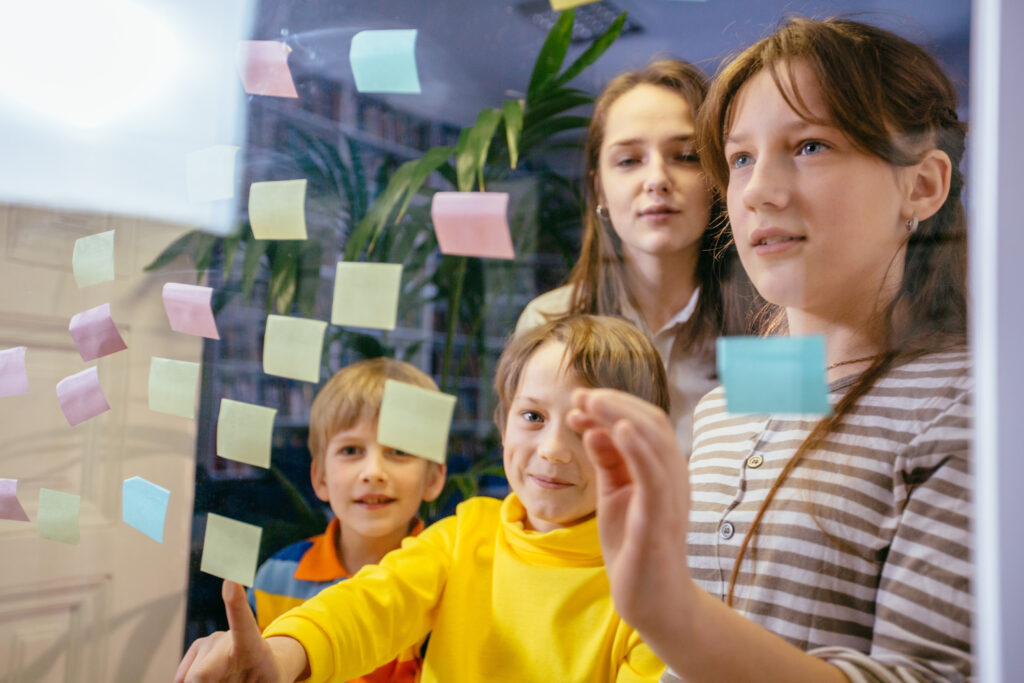
An often-overlooked benefit is the enhancement of communication and social skills among students. Brainstorming isn’t just about generating ideas; it’s a platform where young learners can develop essential life skills.
Fostering Teamwork and Collaboration
- Fostering Teamwork and Collaboration: Brainstorming sessions are a great way to teach students the value of teamwork. As they share and build upon each other’s ideas, they learn the importance of collaboration and mutual respect. Classroom Activity: Engage students in group brainstorming sessions where they have to come up with a solution to a problem or work on a project together. This encourages them to listen, respect diverse opinions, and work cooperatively towards a common goal.
Brainstorming sessions are a great way to teach students the value of teamwork. As they share and build upon each other’s ideas, they learn the importance of collaboration and mutual respect.
- Classroom Activity: Engage students in group brainstorming sessions where they have to come up with a solution to a problem or work on a project together. This encourages them to listen, respect diverse opinions, and work cooperatively towards a common goal.
Developing Effective Communication Skills
Brainstorming also provides an excellent opportunity for students to practice and enhance their communication skills. It’s a safe space where they can express their ideas and learn to articulate their thoughts clearly and confidently.
- Strategy for Teachers: Encourage students to explain their ideas in detail during brainstorming sessions. Ask open-ended questions to prompt deeper thinking and expression. This helps students to clarify their thoughts and communicate more effectively.
Encouraging Active Listening
An integral part of effective communication is active listening. During brainstorming, students learn to listen to others’ ideas, ask questions for clarity, and provide constructive feedback.
- Tip: Teach students the art of active listening by modeling it yourself. Show genuine interest in their ideas, ask follow-up questions, and summarize their points to demonstrate effective listening practices.
Building Empathy and Understanding
Brainstorming in diverse groups helps students understand and empathize with different perspectives. It’s an exercise in seeing the world through someone else’s eyes, which is crucial for developing empathy.
- Classroom Implementation: Use role-playing brainstorming strategies where students have to think from the perspective of different characters or people. This can help them understand and empathize with viewpoints different from their own.
Improving Negotiation and Conflict Resolution Skills
As students discuss and debate ideas during brainstorming, they inevitably learn to negotiate and resolve conflicts. They learn that compromise and consensus are essential in reaching a shared conclusion.
- Practical Approach: When disagreements arise during brainstorming, guide students to find common ground or alternative solutions. This teaches them practical conflict resolution skills.

Bringing It All Together

The integration of brainstorming and collaborative learning in my classroom is not just about imparting academic knowledge; it’s a comprehensive approach to nurturing well-rounded individuals. Through these practices, we’re not only enhancing our students’ intellectual abilities but also significantly contributing to their development as collaborative and empathetic individuals.
Collaborative learning encourages students to work together, share ideas, and learn from each other. This interaction is vital for building strong communication skills, fostering teamwork, and developing a sense of community within the classroom. It prepares students for the real world, where working with others and understanding diverse viewpoints is essential.
By emphasizing brainstorming and collaborative learning, we are doing more than just teaching; we are equipping our students with the tools they need to succeed not only in their academic endeavors but also in their personal and professional lives.

PIN FOR LATER



